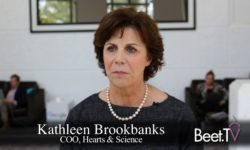NEW YORK – With brands waiting for attribution of their television ad effectiveness, it used to be a case of wanting it “as quickly as possible.” Now it’s “immediately as possible,” according to Alphonso’s T.S. Kelly.
“They want to see that every minute of the day, every hour of the day, every day of the week. That’s really where I see a difference between how we’re working today and just a few years ago.”
In this interview with Beet.TV at the 4A’s Data Summit, Alphonso’s SVP, Research talks about attribution in three phases: pre, during and post ad exposure.
On the pre side, it’s pretty much the way brands have used consumer databases like MRI or Simmons to help advise media and audience selection, according to Kelly. “We can do that directly with brands and their agency partners where we’re taking their CRM data, their first-party data, and creating an audience.”
One example could be an insurance company with homeowner policies coming up for renewal in the next 90 days wanting to know the media behavior of those policy holders. By matching data in a non-personally identifiable manner, Alphonso can provide “a complete analysis of the content they consume. Networks, programs, dayparts, frequency of viewership, that sort of thing.”
The “during” attribution phase involves “what we see in real time.” Exposure activity and the response to it inform whether a particular campaign is working and whether adjustments need to be made. On the post side, “that’s where the performance numbers come in for attribution.”
Alphonso’s biggest data set is its automatic content recognition footprint in 34 million households—roughly one out of four TV households. On the “ingestion” side, it “watches” 200-plus live national networks in some 10 DMA’s. Knowing what households are watching constitutes the “exposure” side and a match is done.
“From there we can understand audience size, ad interaction, and then connect that to all the other types of attribution that are possible,” Kelly says.
The company’s SDK resides not only within TV sets but also connected-TV devices and more than 1,000 apps in the United States. “Every few microseconds on the app side we’re tapping the microphone to see whether or not we recognize what’s on the TV. It’s about understanding what’s on the TV. We’re not listening to peoples’ conversations.”
This video was produced at the 4A’s Data Summit in New York. Please find other videos produced at the conference here.



























